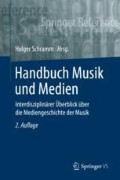Zusammenfassung
Dieses Kapitel thematisiert, was in einer Zeit, in der nahezu jeder Lebensbereich von Computern beherrscht wird, noch unter dem Begriff „Computermusik“ zu verstehen ist. Für diesen Zweck wird die musikalische Anwendung von Computern in den Bereichen Komposition, Klangerzeugung, Klangsteuerung und Klangspeicherung gegenüber gestellt. Dabei wird insbesondere der Bereich der Computerkomposition bzw. algorithmischen Komposition näher untersucht. Dieses Gebiet wird in seiner methodologischen Ausrichtung und historischen Kontinuität betrachtet. Die Beiträge wichtiger Komponisten, wie Lejaren A. Hiller und Iannis Xenakis, zur Entwicklung dieses Bereiches werden ebenso diskutiert wie die Rolle von Computern beim Komponieren mit elektronischen Mitteln im Studio, bei live-elektronischen Anwendungen sowie beim Komponieren für traditionelle Instrumente.
Access this chapter
Tax calculation will be finalised at checkout
Purchases are for personal use only
Literatur
Batel, G. K. (1987). Zur Geschichte der Computermusik. In Computermusik (S. 49–77). Laaber: Laaber Verlag.
Blum, F. (2007). Digital interactive installations. Saarbrücken: VDM Verlag.
Bois, M. (1968). Iannis Xenakis – Der Mensch und sein Werk. Bonn: Boosey & Hawkes.
Boulez, P. (1985). Über Repons – Ein Interview mit Josef Häusler (Teilton 4, Schriftenreihe der Heinrich-Strobel-Stiftung des Südwestfunks). Kassel: Bärenreiter
Brün, H. (1971). Über Music und zum Computer. Karlsruhe: G. Braun.
Cope, D. (2001). Virtual music. Computer synthesis of musical style. Cambridge, MA/London: MIT Press.
Greenberg, G. (1988). Musical learning – Compositional thinking. Proceedings of the ICMC 1988 (S. 150 ff.). Köln: International Computer Music Association.
Hiller, L. A. (1964). Informationstheorie und Computermusik. Mainz: Darmstädter Beiträge zur Neuen Musik VIII.
Hiller, L. A. (1970). Music composed with computers. In H. B. Lincoln (Hrsg.), The computer and music (S. 42–96). Ithaca/London: Cornell University Press.
Hiller, L. A., & Baker, R. A. (1964). Computer cantata: A study in compositional method. Perspectives of New Music, 3(1), 62–90.
Hiller, L. A., & Isaacson, L. (1959). Experimental music. New York: McGraw Hill.
Koenig, G. M. (1973). U. Stürzbecher, Werkstattgespräche mit Komponisten (S. 29). München: dtv.
Koenig, G. M. (1991). Analyse als Teil der Synthese. In A. Ruschkowski (Hrsg.), Die Analyse elektroakustischer Musik – eine Herausforderung an die Musikwissenschaft (S. 19–26). Berlin: Deutsche Gesellschaft für Elektroakustische Musik.
Leopoldseder, H. (Hrsg.). (1990). Der Prix Ars Electronica. Linz: Veritas.
Lindberg, M., Potard, Y., & Saariaho, K. (1988). Esquisse – A compositional environment. Proceedings of the ICMC 1988 (S. 108 ff.). Köln: International Computer Music Association.
Maes, L., Raes, G.-W., & Rogers, T. (2011). The man and machine Robot Orchestra at Logos. Computer Music Journal, 35(4), 28–48.
Magnusson, T. (2014). Herding Cats: Observing Live Coding in the Wild. Computer Music Journal, 38(1), 8–16.
Neumann, P. G., & Schappert, H. (1959). Komponieren mit elektronischen Rechenautomaten. Nachrichtentechnische Zeitschrift, 8, 403 ff.
Olson, H. F. (1967). Music, physics and engineering. New York: Dover.
Prieberg, F. (1960). Musica Ex Machina. Berlin/Frankfurt a. M./Wien: Ullstein.
Rahn, J. (1989). On some computational models of music theory. In C. Roads (Hrsg.), The music machine (S. 663 ff.). Cambridge, MA/London: MIT Press.
Reynolds, R. (1986). Musical production and related Issues at CARL. Proceedings of the ICMC 1986 (S. 228 ff.). Den Haag: International Computer Music Association.
Smallwood, S., Trueman, D., Cook, P. R., & Wang, G. (2008). Composing for Laptop Orchestra. Computer Music Journal, 32(1), 9–25.
Strang, G. (1970). Ethics and esthetics of computer composition. In H. B. Lincoln (Hrsg.), The Computer and Music (S. 39–40). Ithaca/London/New York: Cornell University Press.
Taube, H. (2004). Notes from the metalevel. Introduction to algorithmic music composition. London/New York: Taylor & Francis.
Wang, G. (2014). Ocarina: Designing the iPhone’s magic flute. Computer Music Journal, 38(2), 8–21.
Wright, M., & Freed, A. (1997). Open sound control: A new protocol for communicating with sound synthesizers. International computer music conference. Thessaloniki.
Xenakis, I. (1956, Juli). La crise de la musique serielle. Gravesaner Blätter Nr. 1.
Author information
Authors and Affiliations
Corresponding author
Editor information
Editors and Affiliations
Rights and permissions
Copyright information
© 2019 Springer Fachmedien Wiesbaden GmbH, ein Teil von Springer Nature
About this chapter
Cite this chapter
Ruschkowski, A. (2019). Computermusik. In: Schramm, H. (eds) Handbuch Musik und Medien. Springer VS, Wiesbaden. https://doi.org/10.1007/978-3-658-21899-7_15
Download citation
DOI: https://doi.org/10.1007/978-3-658-21899-7_15
Published:
Publisher Name: Springer VS, Wiesbaden
Print ISBN: 978-3-658-21898-0
Online ISBN: 978-3-658-21899-7
eBook Packages: Social Science and Law (German Language)

